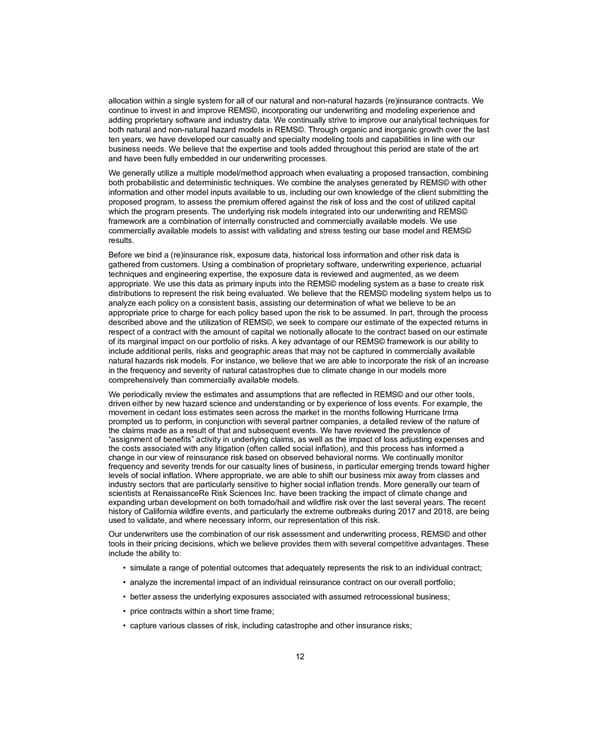allocation within a single system for all of our natural and non-natural hazards (re)insurance contracts. We continue to invest in and improve REMS©, incorporating our underwriting and modeling experience and adding proprietary software and industry data. We continually strive to improve our analytical techniques for both natural and non-natural hazard models in REMS©. Through organic and inorganic growth over the last ten years, we have developed our casualty and specialty modeling tools and capabilities in line with our business needs. We believe that the expertise and tools added throughout this period are state of the art and have been fully embedded in our underwriting processes. We generally utilize a multiple model/method approach when evaluating a proposed transaction, combining both probabilistic and deterministic techniques. We combine the analyses generated by REMS© with other information and other model inputs available to us, including our own knowledge of the client submitting the proposed program, to assess the premium offered against the risk of loss and the cost of utilized capital which the program presents. The underlying risk models integrated into our underwriting and REMS© framework are a combination of internally constructed and commercially available models. We use commercially available models to assist with validating and stress testing our base model and REMS© results. Before we bind a (re)insurance risk, exposure data, historical loss information and other risk data is gathered from customers. Using a combination of proprietary software, underwriting experience, actuarial techniques and engineering expertise, the exposure data is reviewed and augmented, as we deem appropriate. We use this data as primary inputs into the REMS© modeling system as a base to create risk distributions to represent the risk being evaluated. We believe that the REMS© modeling system helps us to analyze each policy on a consistent basis, assisting our determination of what we believe to be an appropriate price to charge for each policy based upon the risk to be assumed. In part, through the process described above and the utilization of REMS©, we seek to compare our estimate of the expected returns in respect of a contract with the amount of capital we notionally allocate to the contract based on our estimate of its marginal impact on our portfolio of risks. A key advantage of our REMS© framework is our ability to include additional perils, risks and geographic areas that may not be captured in commercially available natural hazards risk models. For instance, we believe that we are able to incorporate the risk of an increase in the frequency and severity of natural catastrophes due to climate change in our models more comprehensively than commercially available models. We periodically review the estimates and assumptions that are reflected in REMS© and our other tools, driven either by new hazard science and understanding or by experience of loss events. For example, the movement in cedant loss estimates seen across the market in the months following Hurricane Irma prompted us to perform, in conjunction with several partner companies, a detailed review of the nature of the claims made as a result of that and subsequent events. We have reviewed the prevalence of “assignment of benefits” activity in underlying claims, as well as the impact of loss adjusting expenses and the costs associated with any litigation (often called social inflation), and this process has informed a change in our view of reinsurance risk based on observed behavioral norms. We continually monitor frequency and severity trends for our casualty lines of business, in particular emerging trends toward higher levels of social inflation. Where appropriate, we are able to shift our business mix away from classes and industry sectors that are particularly sensitive to higher social inflation trends. More generally our team of scientists at RenaissanceRe Risk Sciences Inc. have been tracking the impact of climate change and expanding urban development on both tornado/hail and wildfire risk over the last several years. The recent history of California wildfire events, and particularly the extreme outbreaks during 2017 and 2018, are being used to validate, and where necessary inform, our representation of this risk. Our underwriters use the combination of our risk assessment and underwriting process, REMS© and other tools in their pricing decisions, which we believe provides them with several competitive advantages. These include the ability to: • simulate a range of potential outcomes that adequately represents the risk to an individual contract; • analyze the incremental impact of an individual reinsurance contract on our overall portfolio; • better assess the underlying exposures associated with assumed retrocessional business; • price contracts within a short time frame; • capture various classes of risk, including catastrophe and other insurance risks; 12
 2021 Annual Report Page 27 Page 29
2021 Annual Report Page 27 Page 29